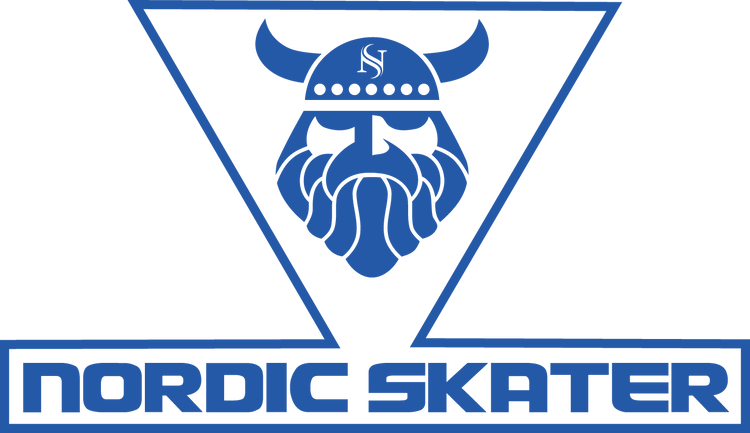Cross Country Ski Types
SKATE SKIS:
- the fastest form of Nordic skiing; appropriate for widely groomed Nordic ski trails
- easy to learn technique that is similar to in-line skating
Skate skis look very similar to the classic track skis below (typically 44mm at the widest point), cosmetically speaking. You can separate them in a line up because skating skis are sized shorter and typically have lower profile tips. The main difference is in their flex and camber, because they are meant to be used with a diagonal stride they do not have a “wax pocket” like other XC skis (therefore they do not work as parallel or classic technique skis). It is most important to get a ski with the proper flex for your weight so that the skis will handle properly and give you good glide. Upper level skate skis get progressively lighter in construction, have a livelier feel and handle more confidently. For the skier with a quiver of skate skis they also come in multiple flexes and with more base structure choices for particular types of snow.
CLASSIC TRACK SKIS:
- stiff, narrow (40-50mm) and fast
- the best choice for groomed and tracked Nordic ski trails
For practical purposes, this category encompasses Nordic skis designed primarily for fast gliding performance. These skis have the stiffest “wax pockets” in a company’s line and come with a very narrow profile and in the longest lengths, giving them exceptional speed in groomed tracks. A skier of any ability level, from the complete novice to the full-time ski instructor can appreciate the benefits offered here. They are best matched with those who live within driving distance of groomed ski trails and are interested in the most aerobically active striding and gliding experience. A lot of these skis possess “waxable” bases but there are a number of good gliding skis with waxless bases.
LIGHT TOURING:
- wider ski dimensions add versatility for both in and out-of-track performance
- skis are more stable and have wider tips for better floatation in soft snow
These skis have the extra width (width at widest point 50-70 mm) to provide adequate flotation and stability for adventures into ungroomed territory. They are great matches for anyone interested in forays through the park, golf course or fields behind the house, places that may have informal ski tracks but no machine set tracks and leveled snow. A ski that has more width underfoot feels more stable on descents and over uneven terrain, and wider tips keep the ski hovering on top of powder rather than plunging beneath it. The camber of these models is softer than what is found in racing ski construction for more kick and user-friendliness. Light touring skis are sized in shorter lengths which aids in maneuverability. As mentioned above, they perform well at Nordic ski areas (just not as fast as Classic Track or Skating skis) and the narrower models can also make dedicated in-track skis for people who want more stability. Light touring gear is well suited for use on the smooth surfaces of groomed Nordic trails in addition to adventures off the beaten path.
BACK COUNTRY TOURING:
- the most versatile skis in the Nordic world, they go from touring the Catamount trail to the groomed tracks with ease.
- very stable and have more control in dicey conditions
When you take a regular touring ski and add metal edges (usually full length) you really have a ski that will inspire confidence. A few are sized in the traditional longer lengths to provide more glide for point-to-point touring, and are suited to old logging roads and remote wilderness areas. Most though are skied shorter for easy maneuvering and increased control. Kick and glide performance is slower than that of classic track or light touring models because of the wider dimensions and increased weight (though these are usually still quite light). To maintain the versatility of being able to slip into prepared tracks in a touring center these need to be no wider at tip than 62mm (a 68mm ski will fit but it’s not ideal as the track setters are 60mm wide at the base).
BACKCOUNTRY:
- the widest skis in the Nordic line-up and the best for “earning your turns”
- much more sidecut make turning a breeze
These skis are specifically designed to handle, as the moniker suggests, rugged terrain. Skis found here are quite a bit wider (tip width 80-130 mm) for much more float in powder than the previous group. All of these offerings are too wide to fit into machine set tracks. These skis are most at home in the powder, exploring backcountry ski trails, fields, and woods looking for turns. Kick and glide performance is much slower than that of classic track or light touring models because of the wider dimensions and weight. Backcountry skis can go just about anywhere you like, but they are not at home on the groomers.

